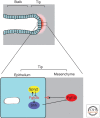Branching morphogenesis: from cells to organs and back
- PMID: 22798543
- PMCID: PMC3475165
- DOI: 10.1101/cshperspect.a008243
Branching morphogenesis: from cells to organs and back
Abstract
Many animal organs, such as the lung, the kidney, the mammary gland, and the vasculature, consist of branched tubular structures that arise through a process known as "branching morphogenesis" that results from the remodeling of epithelial or endothelial sheaths into multicellular tubular networks. In recent years, the combination of molecular biology, forward and reverse genetic approaches, and their complementation by live imaging has started to unravel rules and mechanisms controlling branching processes in animals. Common patterns of branch formation spanning diverse model systems are beginning to emerge that might reflect unifying principles of tubular organ formation.
Figures





References
-
- Affolter M, Caussinus E 2008. Tracheal branching morphogenesis in Drosophila: New insights into cell behaviour and organ architecture. Development 135: 2055–2064 - PubMed
-
- Affolter M, Mann R 2001. Development. Legs, eyes, or wings—selectors and signals make the difference. Science 292: 1080–1081 - PubMed
-
- Affolter M, Zeller R, Caussinus E 2009. Tissue remodelling through branching morphogenesis. Nat Rev Mol Cell Biol 10: 831–842 - PubMed
Publication types
MeSH terms
LinkOut - more resources
Full Text Sources
Molecular Biology Databases
